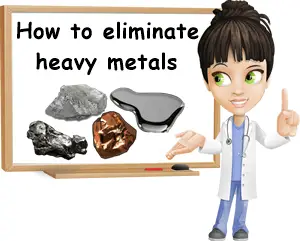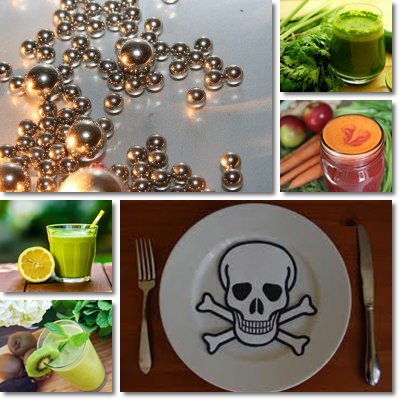Contaminants are everywhere in nature, from the water we drink, air we breathe, soil we grow our fruits and vegetables in to the food we eat. And one major type of contaminants is represented by heavy metals, natural elements which can accumulate in the environment and living tissues producing a toxic effect. Some heavy metals are toxic if ingested, inhaled or handled in any amounts, such as arsenic or mercury. Others like zinc, copper, selenium and chromium are essential for the human body in trace amounts but will produce toxic effects in larger amounts. These elements can accumulate in the human body and produce heavy metal toxicity.
What are heavy metals? The denomination ‘heavy metals’ should not be taken literally because it does not refer to only metals or only metals that are heavy or dense. Actually, heavy metals refers to both metal and non-metal elements which are toxic for the environment and living organisms. For example, lead is a heavy metal and so are methyl-mercury from fish and other seafood or arsenic that accumulates in rice. But iron, zinc and copper, three known essential nutrients, are also heavy metals because they produce toxic effects to living organisms when ingested in large amounts. So anything can be a contaminant really if it produces toxic effects.

What is heavy metal contamination and how does it occur? It refers to the environmentally devastating and toxic effects of various naturally occurring metal and non-metal elements on living beings. It is brought about by purposefully handling such elements or inadvertently coming into contact with them. Most of the time, heavy metals contaminate soil and water and are ingested along with either drinking water or the food grown in contaminated soil or from crops irrigated with contaminated water. Polluted air is a source of heavy metal toxicity too: lead in gasoline, car exhaust fumes, factory fumes etc. Other sources of contamination include occupational exposure (paint-making, mining, battery manufacturing etc.), industrial waste, agricultural fertilizers, contaminated skin care products.
Signs and symptoms
What are the symptoms of heavy metal contamination? Heavy metal contamination symptoms and their severity depend on type of exposure, amount exposed to, type of heavy metal, age, access to medical assistance and other factors. Side effects can be short-term or long-term, both potentially life-threatening. Here are some general signs of heavy metal toxicity to look for:
1) Headache, confusion, brain fog, forgetfulness, trouble concentrating.
2) Inexplicable anxiety, irritability, depression.
3) Drowsiness or insomnia.
4) Mood changes, seizures.
5) Cold hands and feet, goiter (heavy metals disrupt endocrine functions).
6) Tingling sensation in hands and feet, muscle twitching, tremors, aches.
7) Difficulty maintaining balance while walking, nerve inflammation.
8) Night sweats, fever, chills, tachycardia, anemia.
9) Metallic taste in the mouth, white tongue.
10) Nausea, vomiting sensation, diarrhea, stomach pain.
11) Gum problems, altered smell and taste (no smell).
12) Skin symptoms, especially rashes, dark spots, inflammation causing exfoliation, blue discoloration of the skin or pallor.
13) Vitamin and mineral deficiencies.
14) Long-term bone, kidney, liver, thyroid, nervous system, muscle, lung problems.
The more severe the symptoms and sudden the onset, the higher the degree of exposure and the more urgent the need for professional medical assistance.

How to eliminate heavy metals from the body? If you suspect heavy metal contamination, go to the nearest hospital for treatment. Contamination from occupational exposure, via inhalation, ingestion or direct skin contact can result in severe, acute symptoms and requires immediate medical attention. Based on the symptoms you will describe, the doctor will perform tests and then provide a treatment called chelation therapy.
What is chelation therapy and what does it do? What chelating therapy does is detoxify the body of heavy metals. This is done with the help a chelating agent which binds to the heavy metals, inactivates them and helps eliminate them from the body. The chelating agents used as treatment are different depending on the heavy metal causing the toxicity. So a lead toxicity will be treated with a different agent than an iron toxicity. Also, chelating therapies may have different routes of administration depending on where the said heavy metal has accumulated in the body (bloodstream, muscles, lungs).
Side effects of chelation therapy may include: fever, nausea, vomiting, hypertension, low calcium levels, cardiac arrest, kidney damage, liver problems, increased cancer risks, allergic reaction etc. Some of these agents used in eliminating one heavy metal from the body can cause others to accumulate, hence the importance of preventing and limiting exposure to heavy metals to begin with.
How to prevent it
Here are the best tips to avoid heavy metals and heavy metal toxicity:
1) Water. If local water resources are contaminated, drink bottled water from a different region or use a filter, depending on the contaminant present.
2) Tooth fillings. Dental amalgams used to fill tooth cavities are often 50% mercury and contain other heavy metals such as copper, silver, tin etc. These traditional fillings can cause a slow heavy metal toxicity over time. Choose natural resins to fill up cavities. Ask you dentist more about other options.
3) Cosmetics and others. Look for make up, skin and hair care products that are certified organic and non-toxic. Read labels and learn to recognize toxic ingredients in the products you use. And remember, the cheapest products, especially those made in China, have been found to have the highest amounts of toxic contaminants.
4) Shoes and clothing. If you have been in a polluted environment, avoid being in your outside shoes indoors, change clothes as soon as you get home and, if needed, take a shower to remove toxins that may have stuck to hair or skin.
5) Limit fish intake. Fish is only healthy in limited amounts. Ocean waters are abundant in organic mercury and every living being in the marine food chain will store various levels of this heavy metal. And it’s not the only one. The higher on the food chain the marine animal is, the more toxic elements it will accumulate. For example, tuna are fish that grow to enormous sizes and one of the biggest sources of methyl-mercury (read more about the benefits and side effects tuna on our fish and seafood page).
It is recommended to eat 1 serving of a certain type of fish, shellfish or crustacean a week and no more than 2-3 servings of seafood per week. And always research where your seafood is coming from.
6) Get away from the city. If you want to live more, don’t live in the city. The air in big cities is so polluted is it bound to affect you over time and cause chronic health issues.
7) Gasoline, burning plastic etc. So many people like the smell of gasoline and actively breathe it in. Stop it. It is highly toxic. Also, avoid fumes of any sorts, especially burning plastic.
8) Batteries. Dispose of old batteries appropriately by taking them to collecting centers that will recycle them. Batteries are one of the worst pollutants and a major source of heavy metal contamination for the environment and every living organism. And of course, we should all recycle everything we possibly can and try to lead a life that impacts the environment as little as possible.
9) Eat organic. Avoid fruits and vegetables with no smell or taste. Eat locally and mostly foods that are in season. If you know a small producer who grows food naturally, get your fruits and vegetables from them, even though they might not be as good looking as those exotic fruits, perfect-looking fruits harvested from another continent two months ago.
10) Take your vitamins. Vitamin C is a powerful natural detoxifying agent which can help detoxify the body from small accumulations of heavy metals, as well as boost immunity and reduce inflammation. Research advocates for a minimum of 500 mg a day. Just as important, enjoy a varied, balanced diet to get all the nourishment you need on a daily basis.
Conclusion
Heavy metal toxicity is a health issue of great concern because of both the short-term and the long-term health risks it is associated with. Treatment is often efficient if administered in time, but prevention remains the only true solution. This is because treatment does not guarantee all symptoms will be reversed and you will regain your former state of health. Some people have permanent nerve damage from heavy metals despite treatment. Also, side effects from the initial exposure to toxic heavy metals as well as side effects from the chelation therapy can appear later in life. So the best way to prevent heavy metal toxicity is to prevent exposure.
